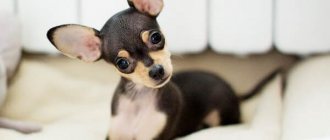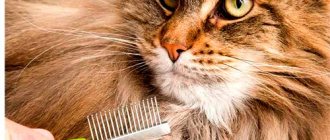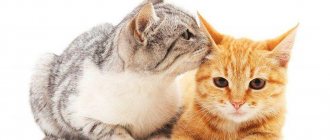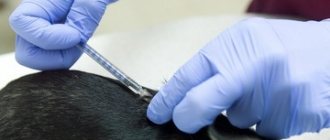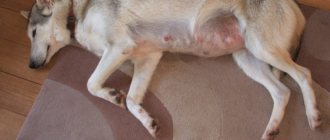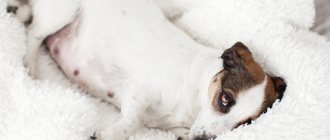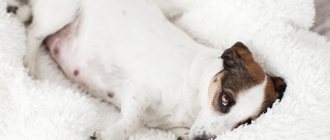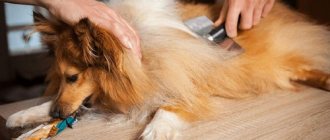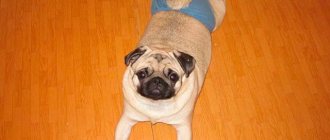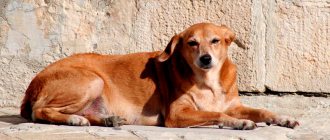Shedding in dogs
Seasonal shedding in dogs
Seasonal molting is the norm and occurs twice a year - in spring and autumn. The animal's fur is completely renewed, which has a good effect on its condition. Summer and winter shedding are less common; in such cases, it is necessary to especially carefully care for the dog in order to identify possible pathologies.
The process of hair renewal is also natural for humans, but this happens no matter what time of year. Therefore, it is not correct to consider shedding in dogs as something unnatural.
The main features and differences of hair loss at different periods of the molting season, considered planned, are:
- Spring molt. In the heat that comes with the arrival of summer, animals have a hard time, because their fur creates additional warmth for them. Therefore, severe shedding is a salvation for representatives of long-haired breeds. The hair is renewed, becomes lighter, and the winter coat is removed. The duration of molting in spring is about two weeks.
- Autumn molt. Unlike spring molting, the result of autumn molting is the acquisition of a warm fur coat. Weak, light hairs are renewed, new ones are stronger and denser. Autumn shedding in dogs begins in late September - early October, depending on weather conditions and the characteristics of the pet. Its duration is also two weeks.
Deviations associated with seasonal molting
Deviations are considered:
- Shedding in summer. Usually begins in June-July, and the pet looks bad. The coat renewed in the spring is thin, so when it falls out suddenly, the animal’s fur becomes shabby, and bald patches appear in some places until the fur grows back there.
- Shedding in dogs in winter. Four-legged animals should not shed during the cold season - the period when frosts begin and the need for dense fur arises.
The main reasons for shedding in summer and winter are:
- a sharp change in temperature, especially when the dog lived on the street for a year, then he was taken to a warm house;
- errors in nutrition: sudden change of food to a lower quality one, insufficient portions;
- allergic reaction - sudden hair loss can occur due to acquired allergies to foods, shampoos, and other things;
- stress associated with an acute situation, often associated with the owner;
- Parasitic diseases are the most serious cause of hair loss and are accompanied by other unpleasant symptoms.
Dogs react especially acutely to any changes in feeding. It is necessary to accustom a puppy to certain foods, dry food, from an early age; a sudden change in food is dangerous not only for the coat, but for the functioning of the internal organs and the general condition of the pet.
What affects hair loss?
Not all owners of four-legged friends know that there are factors that directly affect the molting process. Such factors include:
- natural coat change twice a year. This process is directly affected by the temperature parameters outside the window. Despite the fact that today the climatic zones have shifted somewhat, summer comes later, and, accordingly, the cold too, with the arrival of autumn and before summer, the animal begins to actively lose hair;
- pet's age. The older the dog, the more this process manifests itself;
- sudden move. Changes in climate and time zone negatively affect the dog’s health, and molting is a natural reaction to a change in life activity;
- intense emotional experiences. Experienced stress also causes loss.
Coat change occurs twice a year
In addition to the above reasons, there are others related to the pet’s health.
Seasonal molt
Seasonal shedding is a natural process. Owners need to sound the alarm if this does not happen. Absolutely all healthy dogs shed twice a year. Typically, the process begins in mid-April and ends by mid-May. The same process is activated at the beginning or end of September and ends in October.
In autumn, thin wool that is bleached by direct sunlight falls out. In spring, a significant layer is removed so that the skin is saturated with air and sunlight. If your dog has a thick undercoat, for example a Malamute, then she will have a very difficult time shedding. The fact is that Malamute fur is very hard and sits deep in the skin. It leaves her painfully, annoying. Because of this, the process is very difficult to bear.
Molting begins in mid-April and ends by mid-May, then begins in early or late September, ends in October
In animals that are kept at home and rarely go outside, the molting process may shift back or forward a couple of months. So don't be surprised if your fur starts to fall out in winter or summer. It’s just that the animal does not depend on weather conditions, while the genes remember the need to shed excess hair.
Other reasons
In addition to seasonality, there are other reasons that can affect hair loss. Deviations in a pet’s health can be noticed not only by a veterinarian, but also by an attentive owner. If your dog sheds throughout the year and the process does not stop, you need to check it for the following ailments:
- dermatological problems;
- diseases of the endocrine system;
- nutritional deficiencies;
- parasites;
- lack of vitamins and nutrients in the body;
- hormonal imbalance.
By the way! Female dogs may shed while carrying or nursing puppies.
Lack of vitamins and nutrients in the body negatively affects the dog’s coat.
Over the years, many animals do not receive enough attention from a partner of the opposite sex and begin to feel a riot of hormones. Hormones affect not only general processes in the body, but also affect the appearance of the dog.
Treatment
Shedding cannot be stopped overnight. The owner of the animal must take a whole range of measures in order to alleviate the condition of his pet. Based on the diagnosis, the veterinarian will prescribe treatment that must be followed. Treatment directly depends on the cause that caused such processes in the body.
Hormonal disorders
Hormonal problems are treated by taking estrogens and androgens in minimal proportions. The doctor independently sets the dosage and duration of administration. Every 90 days, the doctor will monitor the health status of his patient. Chloditan is also prescribed 50 ml daily for 2 weeks. Later, the doctor decides to reduce the dose. In some situations, the patient may be prescribed Lugol's solution from 5 to 10 drops.
Lugol's solution
Decreased immunity
Drugs that have a detoxifying effect help to effectively cope with this problem. They increase the body's resistance to stress and stress. The following immunostimulants are offered for dogs:
- Maxidin;
- Glycopene;
- Immunofan;
- Ribotan.
Ribotan
The duration of the course and dosage are prescribed only by the attending veterinarian. Dogs can also be prescribed vitamins in tablet form. Vitamins are given to dogs crushed or dissolved in food. Vitamins should contain the following substances:
- vitamins A, B;
- a nicotinic acid;
- ascorbic acid;
- B5;
- iodine;
- zinc;
- selenium;
- iron.
Kidney failure
Kidney failure, depending on the stage of development of the disease, is treated in several ways:
- antibiotics (Amoxicillin and Biseptol);
- diuretics such as Furosemide;
- drugs containing potassium (Asparkam);
- drugs that eliminate putrefactive processes (Vitom and Lactusan);
- antispasmodics (No-shpa and Papaverine).
It is important to identify renal failure early before severe consequences occur.
Parasitic infestations
If dogs have parasites, the following anthelmintics are prescribed:
- Azinox;
- Azinox plus;
- Dirofen;
- Transit;
- Holiday plus.
Anti-worming medications for dogs
As a rule, as soon as the parasites are destroyed, the hair begins to recover. It is recommended to follow diet and hygiene rules to ensure that animals do not become infected again.
Video - How to deal with shedding
Why does hair fall out in winter?
If any problems happen to the dog, the owner does not notice alarming symptoms until hair loss begins. What is hidden behind molting in winter and what to do?
Unfortunately, unscheduled winter shedding is a problem that most dog lovers face. If you notice that the animal is shedding, carefully analyze the previous month - were there any alarming symptoms? Maybe the dog was itching more than usual or was very lethargic and inactive.
Tip : A good way to stop shedding is to let your dog bathe in clean snow.
Reasons for early shedding in winter (for example, in February):
- Then carefully examine your pet's skin. If there is redness, you are probably dealing with dermatitis . It is easy to cure, but this should only be done under the supervision of a specialist.
- Often, your dog may react to shampoos or other detergents. Do you wash your dog more often than usual in winter?
- A lack of vitamins A and E, as well as fatty amino acids Omega-3 and Omega-6, significantly worsens the condition of dogs' hair, especially in winter and during the off-season. Be sure to take vitamin courses if you feed your dog dry food.
- Impaired body functions may be a reaction to the environment. An animal may react negatively to the reagent or salt that is sprinkled on sidewalks. Carefully examine your pet's paws - are there any wounds or ulcers on them? An unpleasant odor will also be a bad symptom.
- The cause may also be infection by parasites . Fleas or lice can appear on an animal even in winter. Inspect the fur, especially the ears, belly, and inner thighs. Look not only for the insects themselves, but also for traces of their vital activity - red dots from bites and larvae.
IMPORTANT: If you find a lice eater, be sure to take an additional anthelmintic. After all, lice eaters can carry worms.
When does a puppy start shedding for the first time?
The first moult occurs gradually and lasts about two weeks. After birth, the puppy’s body is covered with down, which differs in structure and functionality from the coat of adult dogs. By 3-4 months of age, long hairs usually appear, more rigid in structure.
By 7-8 months of age, a dense undercoat appears; no trace of baby fuzz remains. During this period of time, full-fledged molting begins, it depends on the time of year. For example, if the puppy turned 8 months old in July, hair renewal will begin in the fall, according to the norm. Then he will be 10-11 months old. If the baby is 8 months old in October, then shedding should begin at this time.
Junior shedding (age shedding) is the first coat renewal. This is what they call the first few times, when it is especially abundant. If molting has not occurred before one year, it will no longer occur. A pathology can only arise that provokes hair loss as a symptom of the disease. At the same time, there will be no planned spring or autumn molting.
Most often this is due to the fact that breeders specifically breed dog breeds without shedding and odor. Usually these are small decorative pets that are expensive. If a dog does not shed, and the breed standard suggests its presence, the reasons for this are the same as for non-seasonal shedding: poor nutrition, change in temperature, stress, etc.
Shedding not associated with the season
Most often, non-seasonal molting is associated with such factors.
- Shedding before estrus. With the onset of heat, hormonal changes occur in the female's body, causing hair loss. In its place, a new one immediately begins to grow; this problem is not pathological, that is, there is no reason for concern.
- Shedding after castration. After surgery, the animal’s body does not receive a signal to shed its fur, so this rarely happens. Mostly shedding in the postoperative period occurs due to complications.
- Shedding after childbirth. Occurs in 80% of cases. Postpartum molting is associated either with hormonal changes in the body, or due to a deficiency of vitamins and vital microelements.
Severe shedding on food is common. Products from Brit, Akana and other common premium quality feeds negatively affect the condition of the coat only if the portion is incorrectly selected, undernutrition, or overeating. Also, ready-made dry food can provoke individual intolerance.
When and for how long does the coat change?
Autumn shedding is long-lasting, since its task is to build up a thick undercoat. It begins before frost (it is difficult to name exact dates; it depends on the climate zone and current weather conditions) and can last up to one and a half months. After the autumn molt, the pet seems more voluminous and fluffy.
The spring coat change, on the contrary, is characterized by a rapid shedding of winter fluff and therefore lasts significantly less: 1-2 weeks. It begins as soon as it stops being frosty at night (again, here you need to look not at the calendar, but at the thermometer).
What to do if it is very strong?
The situation is completely different when unscheduled, prolonged or very intense molting begins. This may be a signal of either age-related changes or disruptions in the functioning of the animal’s body.
If you notice that your pet is shedding more or for longer than usual, the first step is to contact your veterinarian. It is better to immediately conduct an examination and, if necessary, get tested.
The most common causes of severe hair loss:
- Insufficient or unbalanced nutrition.
- Lack of vitamins and microelements.
- Dehydration.
- Immune disorders.
- Infestation with parasites.
- Hormonal imbalances.
- Diseases of the gastrointestinal tract, kidneys, liver.
- Endocrine disorders.
- Hepatitis.
- Severe stress (for example, due to moving or separation from the owner for a long time).
- Too frequent bathing using shampoos and other detergents.
- Allergies (to food, shampoos, environmental items, etc.).
To help your pet during periods of intense shedding, you need to brush it daily . This is easy to do with the help of various combs and brushes sold in pet stores. Select a brush that suits your coat type and carry out this procedure at least once a day.
This will not only get rid of hair on the floor and furniture, but will also significantly speed up the shedding process. The coat will renew itself faster and become silkier, because with the brush you are working on the dog’s skin layer, increasing the blood supply to the hair follicles.
IMPORTANT: Short-haired dogs, in addition to combing, must be wiped with a special terry towel. It should be tough to help the dog get rid of excess hair that the brush could not remove.
What is wool cover
Beautiful appearance is one of the most common reasons why future dog owners choose a particular breed. Thick, silky wool, which is so pleasant to run your hands through and stroke, brings unforgettable pleasant sensations during tactile contact.
For a dog, wool is not only a beautiful fur coat to satisfy the owner’s aesthetic taste. For an animal, hair is primarily protection. From climatic conditions, parasite bites, skin damage.
Dog hair consists of three categories:
- Guard hair, protective layer . The one that forms a chic fur coat, so pleasing to our eyes and protecting the dog from all of the above negative factors.
- Undercoat . Shorter and softer than guard hair. Visible if you push apart the fur on the animal’s body with your hands. Serves as thermal insulation.
- Tactile hair . Simply a mustache, one of the pet’s sense organs.
The animal's whiskers do not change to new ones throughout its life. Only the main coat and undercoat are renewed. A newborn puppy has no guard hair, its body is covered only with soft undercoat. Over time, it will fall out and a real fur coat will grow. The thickness, density, length of both the main and secondary hair depends on the type of dog. Some breeds have no undercoat at all.
Caring for your dog's coat during a coat change
When molting begins, experienced owners know what this will mean for their apartment or house. Some residents of private houses evict their pets to the street during this period. In any case, it is important to know how to comb a dog, easing the pet’s condition and making it look attractive. This will also reduce your home cleaning work.
To quickly comb your dog, it is better to use modern devices. When deciding how often to comb the hair, you need to consider how much hair is shed. The best ways to deal with dead hair are:
- brushes;
- furminators;
- slickers.
You need to decide what to scratch your pet based on the characteristics of its breed.
In addition to the fact that you need to properly comb your dog by choosing the right tool, it is important to use the right shampoo. It is recommended to bathe the animal at the end of the coat renewal in order to give it an attractive appearance and speed up molting by removing excess hair.
The dog may itch itself when shedding - this is a sign of lack of proper care on the part of the owner.
Express shedding, offered by many grooming salons, has become a popular procedure. Its essence lies in preparing the fur, combing it with professional tools, bathing, and performing strengthening masks. Express shedding is done using high-quality equipment and materials; the procedure is not carried out at home.
What to do during shedding
Both you and your pet experience discomfort during coat changes. What to do to make this process as easy and quick as possible?
Take your dog's diet seriously. Adjust if necessary. It should contain a sufficient amount of protein and B vitamins. Add special vitamin complexes containing copper and zinc, vitamins B and D or fish oil to strengthen and improve the quality of the coat.
How to deal with hair loss? Combing should become a mandatory and regular procedure. Pet stores offer a wide range of different hair removal devices. The simplest and most accessible of them is a brush. It should be iron, preferably steel with nickel plating. Thick teeth with a slightly curved top are good at removing tangles, matted hair from the undercoat and coarse guard hair.
For the undercoat you can use a slicker brush. It will gently and delicately collect delicate fluff without damaging the skin on the stomach, under the paws, or on the neck. A glove brush is a convenient and effective way to get rid of already fallen hair.
A furminator can be used to groom most breeds. A device that looks like a small rake grabs the undercoat and lifts it up. Its design allows you to remove only loose hair without damaging healthy and growing hair. If it becomes tangled or tangles appear, they must be removed before using the furminator, otherwise it can hurt the dog. You cannot use the furminator if there is damage to the animal’s skin - wounds, scratches, abrasions, ulcers, scratched areas.
To speed up the combing process, you can bathe your dog. Use special dog shampoos with a high protein content. And be prepared that the amount of shedding fur will increase significantly. For several days in a row it will crumble heavily, covering everything around. But, if you scratch your pet well for several days in a row, this period can be reduced to 5-7 days. Frequent bathing during shedding is not recommended.
Conclusion
- Shedding in dogs is divided into natural and unplanned.
- Natural molting occurs in the off-season, that is, in spring and early autumn.
- Unscheduled shedding can occur for natural reasons (estrus, stress, sudden climate change), or it can be an indicator of serious diseases.
- The dog begins to shed at the age of six months.
- It is important to brush your dog regularly to prevent matting.
- You can help your pet during this difficult period with the help of an express shedding service, proper diet and vitamin intake.
Surely each of you has your own secrets. What do you do during shedding? How do you deal with the amount of wool in the house? How is your dog feeling? Share information and, of course, a photo of your wonderful pet!
What to scratch with?
- To remove tangles from the undercoat, you will need a comb made of hardened steel; it would be nice if it was coated with nickel.
- Where a metal tool is not suitable, a more delicate slicker brush will come in handy. Suitable for use in delicate areas.
- A glove-shaped brush is good at removing dead hair from a dog’s body.
- You can quickly rid your beloved pet of dead hair by using a furminator after bathing. The tool should be moved along the growth of the fur, carefully and without pressure.
Important! The dog should not have tangles, which means that before the procedure it is necessary to comb out the hair with a comb or metal comb. If this is not done, the pet will be in too much pain.
What to feed and vitamins
To reduce the negative effects of factors that provoke hair loss, you need to take care of nutrition. Often at this time, animals’ mood deteriorates and their appetite is lost, so special care is needed.
When choosing a diet, you need to take into account the characteristics of the pet’s breed, what foods are allowed and prohibited. It is also advisable to remember the dog’s own preferences. The basis of the diet should be meat, accompanied by nutritious cereals: millet, wheat, buckwheat. Several times a week you need to cook fish and offal.
To compensate for the deficiency of useful microelements, it is recommended to give anti-molting vitamins. An excellent alternative would be fresh vegetables and fruits, but only if the pet eats them voluntarily. If necessary, your veterinarian will help you choose the appropriate vitamin complex.
How to fight: express (artificial)
A so-called “express shedding” service for dogs is currently available. It is offered in almost every pet salon, although some owners carry out this procedure on their own at home.
Express shedding at home for dogs - how is it done? How to speed up shedding?
It consists of washing with a special product in very warm water. Then the mask is applied. The animal is covered with a film and a towel on top. This creates a sauna effect. Thanks to this, the pores open and all the hair ready for shedding is removed much faster.
The mask is washed off, and the coat is thoroughly combed, exposing the coat to hot air using a hairdryer. Express shedding removes almost 90% of shed hair.
IMPORTANT: This procedure is absolutely safe for the animal. But this service is not suitable for dogs that are not accustomed to bathing, brushing and blow-drying.
How dog behavior changes
Most dogs become lethargic and apathy towards everything appears. Behind external hair loss are serious internal processes associated with preparing the body for heat and cold. If molting is not seasonal, it indicates the presence of health problems, the more the animal’s condition worsens.
Many owners are interested in whether dogs lose weight during shedding. When this process is planned, occurs in the spring in the fall, usually not. Why a dog loses weight due to pathological changes that provoked hair loss depends on the root cause. This often occurs due to complications in the postoperative period after castration, sterilization, or childbirth. The loss of kilograms is associated with the general condition of the animal.
Dandruff during shedding is another common problem. It appears with the onset of hair loss and ends with the completion of this process. Usually it is enough to simply wash the coat several times with a special shampoo. If it remains, you need to contact a specialist.
Sometimes dandruff and shedding are not related - these two phenomena can occur simultaneously. If the appearance of “white snow” on the coat lasts for a long time, you need to contact a veterinarian.
When should you seek veterinary help?
A change in coat out of season can have many natural causes, but the presence of accompanying symptoms is a signal of disease. Contact your doctor if:
- Dandruff appeared during shedding. The reasons for this may be fungi, helminth infection, and metabolic disorders.
- The pet is itching a lot. Itching is caused by allergies, fleas, dermatological diseases and hormonal imbalances. Discomfort makes the dog irritable, and there is a risk of secondary infection.
- The dog has lost weight. This is a nonspecific symptom that indicates both the presence of parasites in the body and other gastrointestinal diseases. You need to be examined by a specialist.
- The fur falls out rapidly in clumps.
Useful video on the topic: what to do if your dog sheds a lot?
How to stop shedding
When dogs shed due to health problems or hormonal imbalance, the problem can only be solved by eliminating the root cause. It is useless to stop the usual spring and autumn renewal of the coat. In other cases, general tests are prescribed for increased shedding: blood, urine.
In addition to eliminating the root cause of hair loss, you can use an anti-shedding product. The following drugs are popular:
- Avesect;
- Fiprist;
- Bars-Forte;
- Advantix;
- Stronghold.
They are in the form of drops, sprays, and are intended for treating wool. In parallel with them, oral medications are prescribed. Effective are Adult Multi Vitamin - a vitamin complex, Beaphar, and other vitamins.
Shedding in dogs is a normal process that occurs twice a year. Non-seasonal hair loss is a deviation and serves as a sign of health problems. There are many predisposing factors; it is better to contact a veterinarian for diagnosis and prescription.
The dog sheds constantly, all year round: reasons
Causes of shedding:
- Hormonal disbalance
- Disturbances in the gastrointestinal tract
- Worms
- Dermatitis
- Other parasites
- Stress
- Low indoor humidity
- Heat
The dog sheds constantly, all year round: reasons
Causes
Most often, the reason for year-round hair loss is the poor ecology of our cities and the fairly warm temperature in the room where pets live. However, in fact, the problem is much deeper and is not limited to these two factors. Here are some of the most likely causes of prolonged shedding in your furry friends:
Guessing from the coffee grounds which reason your pet owes its intense shedding is a thankless task. A correct diagnosis will allow you to accurately determine the cause of the pathology and choose the most effective way to combat the problem.
First of all, you should conduct a thorough clinical examination of your pet. An experienced veterinarian will advise you, in addition to a general blood test, to take a test for Giardia (protozoa can also cause hair loss), check markers for thyroid hormones, and also do all sorts of scrapings from the surface of the skin.
If everything is in order with your health, you should take a closer look at the everyday side of your dog’s life. Check the animal's diet, observe whether it is comfortable for him to sleep in his place - there are cases when a hard, uncomfortable bed or rough mattress fabric provoked hair loss, especially in small dogs with fine hair.
It should be remembered that there are breeds that initially lose hair more intensively than other dogs. This most often applies to northern native species that are not accustomed to living in warm and cramped apartments. For a Malamute, husky or prolonged molting in urban conditions is a completely natural phenomenon.
How long does it last
The average duration of molting is from 7 to 14 days. It all depends, firstly, on the breed of the pet. The longer and thicker the coat, the longer it will take to change the coat. Secondly, animals that live in an apartment or house all year round cease to react sharply to temperature changes. Therefore, their molting can continue all year, only slightly intensifying in spring and autumn.
The described process refers to natural or planned molting . It is impossible to avoid it or influence its speed, so during such periods it is important to help your pet by brushing it daily.
The condition of a dog's coat is an indicator of its health. Ideally, the coat should be smooth, silky and shiny. If you notice that every day your hair becomes duller, hair constantly falls out, bald spots appear or looks sloppy, immediately contact a specialist. The sooner you diagnose the cause of the illness, the sooner you can begin treatment.
Feeding the dog
In order for your dog to be healthy, active, and have a shiny coat, you must organize complete feeding, balanced in proteins, fats, carbohydrates, minerals and vitamins. If there is a lack of vitamins in the diet, vitamin preparations (vitamins for dogs) must be added to the diet.
A dog's fur may fall out in the summer, even if it is practically healthy. This happens to those dogs whose owners use shampoos intended for humans when bathing their dogs. The dog owner needs to know that the structure of the skin of a dog and a person is different, as a result, human shampoo can provoke shedding and an allergic reaction in the dog. However, you can purchase a special shampoo that will prevent healthy hair loss.
You should not bathe your dog more than once a month. When bathing, use lukewarm water. Using hot water will cause your dog to become stressed.
